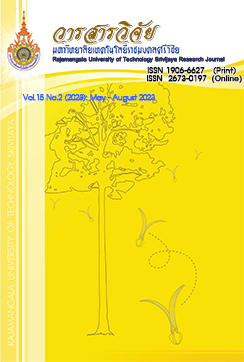Compressive strength, Water Abortion and Length Change of Concrete Block Made from Alkali Activated Fly Ash
Keywords:
concrete block, alkali activated, fly ash, water absorption, length changeAbstract
This research aims to study the properties of concrete block made from alkali activated fly ash to use as cementitious material without Portland cement. Sodium hydroxide and sodium silicate solutions were used as an alkaline solution in the mixture of alkali activated fly ash. The compressive strength of concrete block was determined at 7, 14 and 28 days. The water absorption and change in length after immersed in water were also investigated at 28 days. The result found that the compressive strength of concrete block made from alkali activated as a cementitious material was increased with curing age. The using of sodium hydroxide combined with sodium silicate solution (FA-6M-NS concrete) was achieved the highest compressive strength, which could be developed compressive strength up to 249 kg/cm2 at 28 days. The test results of water absorption and length change when immersed in water of concrete block made from alkali activated fly ash were ranging from 9.4 - 10.5 % and 0.12 - 0.33 %, respectively. Moreover, the concrete block made from alkali activated fly ash had significantly less release CO2 emission than that of concrete using Portland cement as binder, which was eco-friendly material when compared with CO2 emission obtained from raw materials.
References
Abdel-Gawwad, H.A., Mohammed, M.S. and Zakey, S.E. 2020. Preparation, performance, and stability of alkali-activated-concrete waste-lead-bearing sludge composites. Journal of Cleaner Production 259: 120924.
Abdulmatin, A., Tangchirapat, W. and Jaturapitakkul, C. 2019. Environmentally friendly interlocking concrete paving block containing new cementing material and recycled concrete aggregate. European Journal of Environmental and Civil Engineering 23(12): 1467-1484.
ASTM C618. 2019. Standard Specification for Coal Fly Ash and Raw or Calcined Natural Pozzolan for Use in Concrete. American Society for Testing and Materials, West Conshohocken, PA.
Dueramae, S., Tangchirapat, W., Sukontasukkul, P., Chindaprasirt, P. and Jaturapitakkul, C. 2019. Investigation of compressive strength and microstructures of activated cement free binder from fly ash-calcium carbide residue mixture. Journal of Materials Research and Technology 8(5): 4757-4765.
Gavali, H.R., Bras, A., Faria, P. and Ralegaonkar, R.V. 2019. Development of sustainable alkali-activated bricks using industrial wastes. Construction and Building Materials 215: 180-191.
Lee, W.H., Cheng, T.W., Lin, K.Y., Lin, K.L., Wu, C.C. and Tsai, C.T. 2020. Geopolymer technologies for stabilization of basic oxygen furnace slags and sustainable application as construction materials. Sustainability 12(12): 5002.
Liew, Y.M., Kamarudin, H., Al Bakri, A.M., Bnhussain, M., Luqman, M., Nizar, I.K., Ruzaidi C.M. and Heah, C.Y. 2012. Optimization of solids-to-liquid and alkali activator ratios of calcined kaolin geopolymeric powder. Construction and Building Materials 37: 440-1451.
Matalkah, F. and Soroushian, P. 2018. Synthesis and characterization of alkali aluminosilicate hydraulic cement that meets standard requirements for general use. Construction and Building Materials 158: 42-49.
Mehta, P.K. 2009. Global concrete industry sustainability. Concrete International 33(2): 45-48.
Nadoushan, M.J. and Ramezanianpour, A.A. 2016. The effect of type and concentration of activators on flowability and compressive strength of natural pozzolan and slag-based geopolymers. Construction and Building Materials 111: 337-347.
Najimi, M. and Ghafoori, N. 2019. Engineering properties of natural pozzolan/slag based alkali-activated concrete. Construction and Building Materials 208: 46-62.
Namarak, C., Bumrungsri, C., Tangchirapat, W. and Jaturapitakkul, C. 2018. Development of concrete paving blocks prepared from waste materials without portland cement. Materials Science 24(1): 92-99.
Pangdaeng, S., Phoo-ngernkham, T., Sata, V. and Chindaprasirt, P. 2014. Influence of curing conditions on properties of high calcium fly ash geopolymer containing Portland cement as additive. Materials & Design 53: 269-274.
Puertas, F., Martıńez-Ramıŕez, S., Alonso, S. and Vazquez, T. 2000. Alkali-activated fly ash/slag cements: Strength behavior and hydration products. Cement and Concrete Research 3(10): 1625-1632.
Rifaai, Y., Yahia, A., Mostafa, A., Aggoun, S. and Kadri, E.H. 2019. Rheology of fly ash-based geopolymer: effect of NaOH concentration. Construction and Building Materials 223: 583-594.
Ryu, G.S., Lee, Y.B., Koh, K.T. and Chung, Y.S. 2013. The mechanical properties of fly ash-based geopolymer concrete with alkaline activators. Construction and Building Materials 47: 409-418.
Singh, G.B. and Subramaniam, K.V. 2017. Evaluation of sodium content and sodium hydroxide molarity on compressive strength of alkali activated low-calcium fly ash. Cement and Concrete Composites 81: 122-132.
The Office of Industrial Economics. 2020. Industrial Economic Summary Report 2020 and Industrial Economic Trend 2021. Industrial Situations. Available Source: http://www.oie.go.th/assets/portals/1/fileups/2/files/Industry%20conditions/annual2020trends2021.pdf, September 10, 2021. (in Thai)
TIS 57. 1990. Hollow Loadbearing Concrete Masonry Units. Thai industrial standards institute, Thailand. (in Thai)
Turner, L.K. and Collins, F.G. 2013. Carbon dioxide equivalent (CO2-e) emissions: A comparison between geopolymer and OPC cement concrete. Construction and Building Materials 43: 125-130.
Downloads
Published
How to Cite
Issue
Section
License
Copyright (c) 2023 Rajamangala University of Technology Srivijaya Research Journal

This work is licensed under a Creative Commons Attribution-NonCommercial-NoDerivatives 4.0 International License.
The content and information in the article published in Journal of Rajamangala University of Technology Srivijaya It is the opinion and responsibility of the author of the article. The editorial journals do not need to agree. Or share any responsibility.







